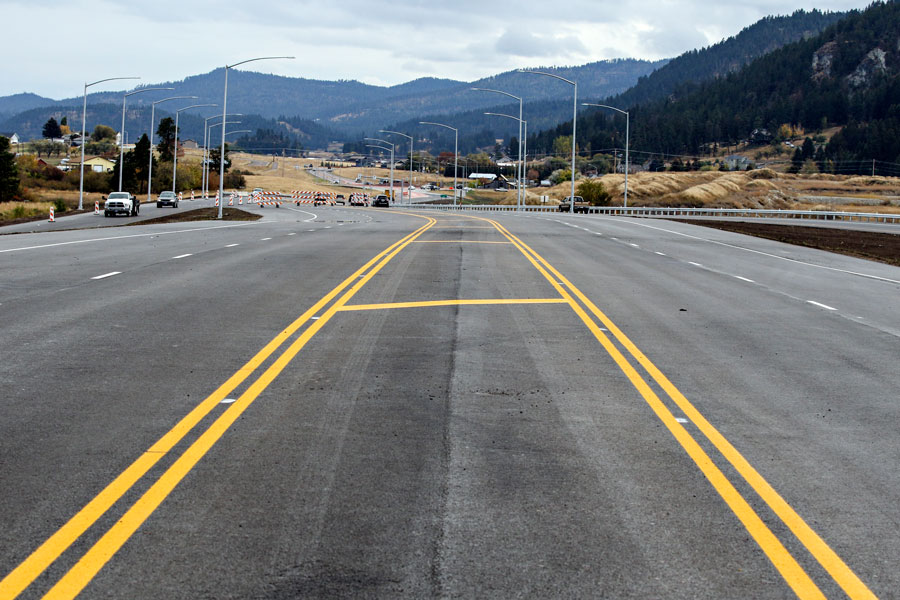A delegation of more than a dozen Flathead Valley officials traveled to Washington D.C. last week to state their case for receiving federal funding to complete full build-out of the Foys Lake roundabout section of the U.S. Highway 93 bypass.
They returned feeling optimistic about the project’s chances of receiving the $15 million in BUILD grants from the U.S. Department of Transportation, which would help fund the $20 million project, with the remaining $5 million coming from the Montana Department of Transportation (MDT).
If secured, the funding will go toward widening a roughly 2-mile stretch of the southern section of the bypass, between the Ashley Creek bridge and the southern tip of the sound wall, from two lanes to four. It would also remove the often-congested Foys roundabout and replace it with an overpass interchange with ramps, meaning Foys Lake Road will go over the bypass.
City of Kalispell and Flathead County officials were joined by economic and community leaders on the trip, which kicked off with Sept. 5 meetings with the Montana congressional delegation: U.S. Sens. Steve Daines and Jon Tester and Rep. Greg Gianforte.
“Our delegation was really supportive and positive,” Kalispell Chamber of Commerce President and CEO Joe Unterreiner said of the two senators and congressman. “We’re very optimistic.”
The city of Kalispell is the lead agency on the federal grant application, submitted in July in conjunction with the MDT. Partners and supporters include Flathead County, the Kalispell Chamber of Commerce and a long list of other Northwest Montana economic and community organizations.
Although the bypass, also known as the U.S. Highway 93 Alternate Route, opened to traffic in October 2016, only the northern portion is complete with four lanes and overpass interchanges. The BUILD funding would bring the bypass one step closer to full build-out, leaving only the remaining southern tip with two lanes and roundabouts.
Ed Toavs, the MDT’s western district administrator, has previously said the project’s chances are boosted by its shovel readiness, availability of data demonstrating need, community support and broad cooperation among different partners.
Katharine King, assistant director of community development for the city of Kalispell and a member of last week’s D.C. delegation, echoed Toavs, pointing to a June 27 letter sent by 15 Northwest Montana chambers of commerce, tourism bureaus, downtown associations and economic development groups to U.S. Transportation Secretary Elaine Chao voicing support for the funding.
“It demonstrated the strong and diverse community support for the project, and that’s a really important aspect,” King said.
Toavs said pre-construction estimates pegged traffic flow along the Foys Lake stretch at 16,000-18,000 cars per day by 2040. It’s already reached that number, and is higher in some areas on the north side.
Toavs co-authored a study with University of Idaho professor Steve Peterson released last year that measured the economic impact over the life of the alternate route’s construction, from 2001-2016, at $1.12 billion, including new residential and commercial development, sales and wages associated with 760 jobs a year. Toavs said that number has been updated to $1.4 billion, providing further useful data in the application.
King said there are 870 applications nationwide seeking a chunk of the available $1.5 billion in BUILD funding, and 30 percent of the funding must be awarded to projects in rural areas, boosting the bypass’s odds.
BUILD is the successor to the TIGER program. The city of Kalispell received a $10 million TIGER grant in 2015 to help fund its industrial park and core redevelopment project, which is currently in progress.
“We’re hopeful that this project will get selected,” King said. “It’s very competitive, as it was under TIGER, but there’s quite a bit more money available this time around.”
Among other highlights of the D.C. trip, Unterreiner said, was attending the U.S. Chamber of Commerce’s transportation infrastructure committee meeting, followed by a personal conversation with Deputy Secretary of Transportation Jeffrey Rosen.
“I was able to connect with him after the meeting and make a little pitch for the project,” Unterreiner said.
Other delegation members were John Kania of Applied Materials; Kalispell City Manager Doug Russell; Kalispell Mayor Mark Johnson; Flathead County Commissioner Pam Holmquist; Glacier Bank President Bob Nystuen and his wife, Kim; Kalispell Chamber of Commerce Board Chairman Dave Hergesheimer, a managing partner at Jordahl & Sliter; U.S. Chamber of Commerce Northwest Regional Director Chris Eyler; Bob Harris of Weyerhaeuser; and Valley Bank Chairman of the Board Mark Hensley.
The delegation also learned that grant recipients could be announced earlier than the originally listed date of Dec. 18, which would be welcome news for a project that is ready to go as soon as funding is available, King and Unterreiner said.
“That would be great for us if it works out that way,” Unterreiner said. “It would allow us to get started more quickly.”
